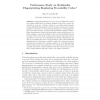Free Online Productivity Tools
i2Speak
i2Symbol
i2OCR
iTex2Img
iWeb2Print
iWeb2Shot
i2Type
iPdf2Split
iPdf2Merge
i2Bopomofo
i2Arabic
i2Style
i2Image
i2PDF
iLatex2Rtf
Sci2ools
110
click to vote
IWDW
2005
Springer
2005
Springer
Performance Study on Multimedia Fingerprinting Employing Traceability Codes
Digital fingerprinting is a tool to protect multimedia content from illegal redistribution by uniquely marking copies of the content distributed to each user. Collusion attack is a powerful attack whereby several differently-fingerprinted copies of the same content are combined together to attenuate or even remove the fingerprint. Coded fingerprinting is one major category of fingerprinting techniques against collusion. Many fingerprinting codes are proposed with tracing capability and collusion resistance, such as Traceability (TA) codes and Identifiable Parent Property (IPP) codes. Most of these works treat the important embedue in terms of a set of simplified and abstract assumptions, and they do not examine the end-to-end performance of the coded multimedia fingerprinting. In this paper we jointly consider the coding and embedding issues and examine the collusion resistance of coded fingerprinting systems with various code parameters. Our results show that TA codes gener...
| Added | 28 Jun 2010 |
| Updated | 28 Jun 2010 |
| Type | Conference |
| Year | 2005 |
| Where | IWDW |
| Authors | Shan He, Min Wu |
Comments (0)

